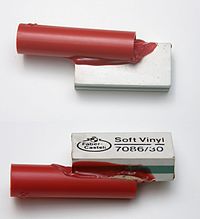
Photo from wikipedia
Abstract Organic ionic plastic crystals (OIPCs) have been studied as solid-state electrolytes because of their desirable properties such as non-flammability, plasticity, and ionic conductivity. However, the temperature range of their… Click to show full abstract
Abstract Organic ionic plastic crystals (OIPCs) have been studied as solid-state electrolytes because of their desirable properties such as non-flammability, plasticity, and ionic conductivity. However, the temperature range of their conductive plastic crystal phase is narrow. We previously reported that N-ethyl-N-methylpyrrolidinium bis(fluorosulfonyl)amide ([C2mpyr][FSA]) exhibited a wide temperature range of plastic crystal behavior and high ionic conductivity at room temperature. In this study, the relationship between the side chain structure of pyrrolidinium and the physicochemical properties of their compounds with FSA was investigated. With two introduced ethyl groups, N,N-diethylpyrrolidinium bis(fluorosulfonyl)amide ([C2epyr][FSA]) showed higher ionic conductivity than [C2mpyr][FSA], while maintaining a sufficient temperature range of plastic crystal phase. The ionic conductivity of [C2epyr][FSA] was further improved by the addition of 5 mol% LiFSA. For the [C2epyr][FSA] composited with 5 mol% LiFSA, the lithium transference number was determined to be 0.27 at 60 °C. Reversible lithium plating/stripping reaction was observed on a Ni electrode in the CV measurement. Symmetric pyrrolidinium cation with a longer alkyl chain (up to two carbons) showed conductive plastic solid phase in a wide temperature range and a higher lithium transference number.
Journal Title: Electrochimica Acta
Year Published: 2019
Link to full text (if available)
Share on Social Media: Sign Up to like & get
recommendations!